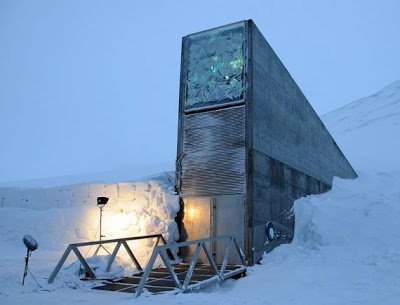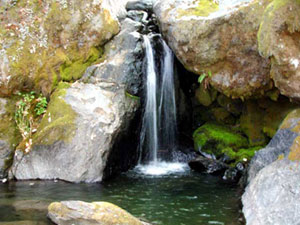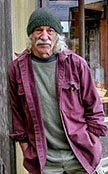 “In order to preserve gene diversity of major food crops, international institutions have established a series of green gene banks, which store samples of genetic material of various strains of each plant species.
“In order to preserve gene diversity of major food crops, international institutions have established a series of green gene banks, which store samples of genetic material of various strains of each plant species.
“…Svalbard Seed Bank is meant as a sort of safety net, a reserve of last resort and the vault functions like a genetic safety deposit box. It stores duplicate specimens from genebanks worldwide and while the Svalbard seed bank owns the building, the individual depositor owns the contents of his or her box and the access to individual specimens is regulated by their respective depositors.
Read More …
At Zen farm at Green Gulch last night at dusk

 Got up at 4:30 yesterday AM and drove down Hwy 1 along the coast to Santa Cruz to see grandson Maceo and his parents and some old surfing friends. Was deeply foggy and actually raining in Pacifica. I love this drive, been doing it since I was 18, mothership (San Francisco) to beach fun (Santa Cruz). Artichoke, brussels sprouts, strawberry fields alongside the ocean. Down Swift St., past Haut’s shop, West Cliff Drive to Steamer Lane. (Don’t get me started on the old days (50s) in Santa Cruz…sniffle, sniffle…)
Got up at 4:30 yesterday AM and drove down Hwy 1 along the coast to Santa Cruz to see grandson Maceo and his parents and some old surfing friends. Was deeply foggy and actually raining in Pacifica. I love this drive, been doing it since I was 18, mothership (San Francisco) to beach fun (Santa Cruz). Artichoke, brussels sprouts, strawberry fields alongside the ocean. Down Swift St., past Haut’s shop, West Cliff Drive to Steamer Lane. (Don’t get me started on the old days (50s) in Santa Cruz…sniffle, sniffle…)
A few photos: Swanton Berry Farm, I highly recommend stopping there. Union workers, organic strawberries (and shortcake), good coffee, vintage photos of the area 100 years ago. Totally good place.
A little further south, I spotted this hidden road down to beach. Mental note to go down it on a future trip, maybe taking surf matt and fins…



Farm buildings: it must be the 3rd or 4th time I’ve shot pics of this little barn that looks like it’s floating. Farmer’s architectural zinger. This time I shot other buildings as well.

Seems almost too good to be true. From Treehugger.com via Permaculture Forum:
 “StoneLake Farm is a unique 21-acre off the grid homestead located in Humboldt County, approximately 60 miles southeast of Arcata, California. Close to redwood groves and wild rivers, high on the southwest flank of Buck Mountain, our small farm has dairy, pack, and Angora goats, chickens, a large garden, orchards, a lively creek complete with dipping holes, flowing waterfalls, and stunning vistas.
“StoneLake Farm is a unique 21-acre off the grid homestead located in Humboldt County, approximately 60 miles southeast of Arcata, California. Close to redwood groves and wild rivers, high on the southwest flank of Buck Mountain, our small farm has dairy, pack, and Angora goats, chickens, a large garden, orchards, a lively creek complete with dipping holes, flowing waterfalls, and stunning vistas.
Our hand-made octagon is available for rentals, we offer internships and are accepting applications for our artist-in-residence program.”
https://www.stonelakefarm.com/

 A bunch of good books for people getting into food production, on whatever scale: https://www.goodearthpublications.com/
A bunch of good books for people getting into food production, on whatever scale: https://www.goodearthpublications.com/
Regarding this book:’
“City Chicks describes in detail how chicken’s “skill sets’ can be employed in a ‘Hen-Have-More Plan’ for food production systems. Instead of using oil-based chemicals, chickens can help produce fertilizer and compost; they can turn yard waste into garden soil. Hens can also be used as mobile, clucking, (organic and non-toxic), pesticiders, herbiciders, and insecticides.
And chickens can be of civic service. One chicken eats about 7 pounds of food ‘waste’ a month. A few hundred households keeping micro-flocks of laying hens can divert tons of yard and food biomass ‘waste’ from trash collection saving municipalities millions, even billions of tax payer $$
‘What if a city had 2,000 households with three hens (or more) each? That could translate to 252 tons of food waste diverted from landfills each year … Add to that number the tons of yard waste (grass clippings and leaves) that can hens can help convert into compost and the amount is as enormous as the tax-savings of NOT having to handle, transport and store all that biomass waste’.”
Boy is this beautiful!
Be sure to click on the 4 little arrows at lower right side of screen to enlarge. This is just magnificent.
Discovered by Lew Lewandowski
https://www.youtube.com/watch?v=2HiUMlOz4UQ
Tags: animals, birds, building, farming, fishing, gardening, homes, nature, ocean, people, surfing Veiko Lasting sent us this link to an open air museum on Estonia that, among other displays, has a number (12) of Estonian farms shown in “virtualtour” 360º panoramas. https://www.evm.ee/keel/eng/
 “The Estonian Open Air Museum is akin to a village, with 12 farms, as well as its own church, tavern and schoolhouse. There are a number of mills, a fire station, fishing net sheds as well as a dancing area and a village swing.
“The Estonian Open Air Museum is akin to a village, with 12 farms, as well as its own church, tavern and schoolhouse. There are a number of mills, a fire station, fishing net sheds as well as a dancing area and a village swing.
The museum is located in a lovely, well-maintained forest park on a high sandstone bank on Kopli Bay, just 15 minutes drive from the center of Tallinn.”
 “In order to preserve gene diversity of major food crops, international institutions have established a series of green gene banks, which store samples of genetic material of various strains of each plant species.
“In order to preserve gene diversity of major food crops, international institutions have established a series of green gene banks, which store samples of genetic material of various strains of each plant species.










